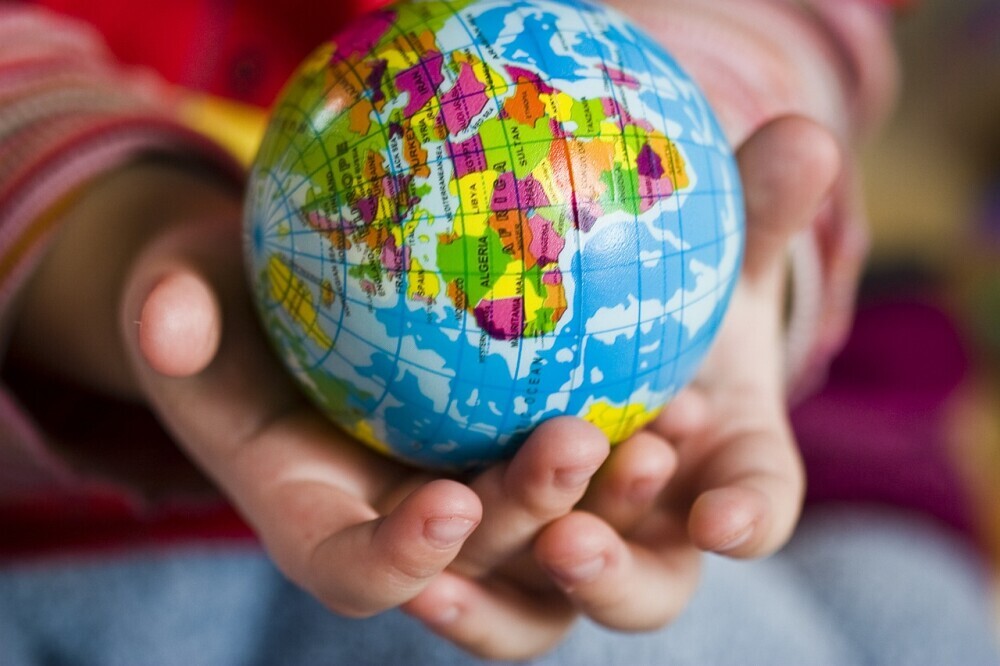This post may contain affiliate links. When you click and purchase from any of our links, we may get a small commission at no extra cost to you. For more information, please see our affiliate disclosure.
Geography can be so much fun, especially when you kick things off with map skills. Start out with something dynamic like a ‘Treasure Hunt’ for your young explorers. Create simple maps of your backyard or living room, highlighting key spots where prizes or clues can be found. It’s an awesome way to get kids moving and using their heads.
Want to ramp up the creativity? Craft a colorful world map collage. Grab some old magazines, cut out pictures of different landscapes, and patch them together on a large poster. As you assemble different pieces of the world, chat with your kids about what makes each place special. It’s like a little geography art class right in your kitchen.
Introducing cardinal directions can be a neat challenge too. Get your hands on a simple compass, maybe even let the kids make their own using a needle and a magnet. Explore your neighborhood or a local park. See if they can figure out which way is North or South. They’ll start seeing the world in a whole new way.
The best part? These activities aren’t just games. They build a foundation for real-world map skills that can help kids all throughout their lives. Think of them as the first steps toward becoming a world explorer. Just imagine the possibilities as they grow more confident navigating both paper maps and the digital kind.
Hands-On Discovery
Let’s get those hands busy and dive right into the wonders of geography through crafts. How about starting with a topographic model of the area where you live? Use different colors of clay or papier-mâché to build mountains, valleys, and rivers. It’s like bringing a map to life on your dining room table.
Creating a DIY globe can be another fantastic project. Blow up a balloon, cover it with strips of newspaper dipped in glue, then paint on the continents. This globe-making activity offers a three-dimensional understanding of the Earth while adding a splash of creativity.
For those rainy afternoons, why not build a recycled bottle Earth model? Raid the recycling bin for bottles and turn them into an Earth with layers. Use colored markers to show the core, mantle, and crust. It’s a fun way to learn about earth structures while giving some recyclables a new purpose.
Learning about the earth’s layers with clay can also offer an engaging, tactile experience. Layer different colors of clay to represent the different strata of the Earth. As kids slice into their clay models, they’ll see how each layer stacks, sparking curiosity about what lies beneath Earth’s surface.
Nature as a Classroom
Shake off those indoor vibes and turn the great outdoors into a living classroom. Start with a simple outdoor scavenger hunt, where kids get to discover natural features right in their backyard or a local park. Make a list of items like specific leaves, rocks, or insects to find. Not only does this encourage exploration, but it also provides a chance to learn names and details about local flora and fauna.
Nature walks can be an enlightening way to show different landforms and ecosystems. Walk along a trail or a beach and point out things like hills, valleys, swamps, or dunes. Explain how these landforms came to be. These walks offer firsthand knowledge that no textbook can match.
To keep it local, try identifying neighborhood landmarks. It’s amazing what you notice when you start to look at everyday surroundings with a keen eye. Challenge the kids to spot different types of buildings, trees, or public art. This can grow their understanding of how geography shapes communities.
Connecting geography to the immediate environment fosters a deeper respect for the Earth. Outdoor activities allow children to feel the textures, smell the scents, and hear the sounds of the world around them, making learning truly immersive.
And don’t overlook the stories that come with these adventures. Young explorers often have the best tales to share, whether it’s spotting a deer on a hike or finding a perfectly smooth stone by the river. These experiences turn learning into cherished memories.
Culture Connections
Dive into the rich tapestry of cultures from around the globe with your young explorers. It’s a fantastic way to look beyond maps and landforms. Start with traditional stories from different countries. Fairy tales and folklore can bring a slice of life from far-off places right into your living room. Discuss the morals and lessons, and maybe even act them out.
Get hands-on with global cooking. Prepare a dish from another country together, like Italian pasta or Japanese sushi. This not only teaches about different food but also highlights diverse traditions and lifestyles. Plus, it’s a yummy way to learn.
Virtual travel tours can add another layer of cultural immersion. Explore digital maps or 3D models of famous landmarks. Walk the halls of the Louvre, roam the streets of Tokyo, or visit the pyramids of Egypt without leaving home. These tours provide a visual taste of distant lands, igniting a desire to learn more.
Try out cultural games from around the world. Many traditional games have been passed down through generations, like Mancala from Africa or kite flying in Asia. Playing these games can offer insight into the values and creativity of different societies.
These activities ground geography in real-world experiences, making cultures from around the world feel closer and more connected. The more kids understand about cultural diversity, the more they appreciate the mosaic of humanity.
Games and Digital Learning
Blend fun with technology to expand those geography horizons. Geography-themed board games like Ticket to Ride or 10 Days in Europe can foster strategic thinking while boosting a sense of global geography. They’re perfect for family game night, offering laughter and learning in equal measure.
Interactive apps provide dynamic ways to explore the world. Try apps that offer puzzles, quizzes, and virtual tours. These tools assign kids the role of world travelers, sparking curiosity and reinforcing knowledge with each correct answer.
Virtual reality options provide a whole new level of engagement. Slip on a VR headset and suddenly you’re standing in the middle of a bustling city or a serene rainforest. This vivid immersion helps kids to experience geography viscerally, making it both memorable and impactful.
Balancing screen time and physical activities is key. Encourage kids to take what they learn on a screen and find real-life connections. For example, if they’ve explored rainforests virtually, plan a trip to a local greenhouse to experience similar plants in person.
It’s always inspiring to hear stories of success from families who’ve integrated digital learning tools into their geography adventures. From mastering capital cities to understanding climate zones, these tools can be game-changers in making geography education fun and meaningful.
15 Fun Geography Activities for Young Explorers Recap
- Backyard Treasure Hunt
Create simple maps highlighting spots where kids can find clues or prizes. This activity gets them moving while developing map-reading skills. - World Map Collage
Use old magazines to cut out pictures representing various landscapes. It’s a hands-on way to discuss global geography and culture. - Cardinal Directions with Compass
Teach cardinal directions using a compass. Let kids explore your neighborhood and figure out North, South, East, and West. - Topographic Model with Clay
Build mountains, valleys, and rivers using colored clay to create a topographic map of your local area, offering a hands-on geography lesson. - DIY Globe Project
Make a globe by covering a balloon with papier-mâché. This 3D model helps children visualize the Earth’s continents and countries. - Recycled Earth Model
Use recycled bottles to create an Earth model showing the core, mantle, and crust. It’s a great way to learn about Earth’s layers. - Nature Scavenger Hunt
Head outdoors for a scavenger hunt where kids look for specific leaves, rocks, and insects, while learning about local flora and fauna. - Nature Walks to Explore Landforms
Take a walk through a park or beach, pointing out natural features like hills, valleys, and dunes. Discuss how these landforms formed. - Identify Neighborhood Landmarks
Explore your neighborhood and challenge kids to spot different buildings, trees, or public art, learning how geography shapes local communities. - Storytime with Global Folklore
Read and discuss traditional stories from around the world. Act them out to immerse kids in the cultures they represent. - Global Cooking Project
Prepare a dish from another country to explore different food traditions. This activity connects geography with culture through taste. - Virtual Travel Tours
Take virtual tours of famous landmarks using digital maps or 3D models. Visit places like the Louvre, Tokyo, or the Pyramids of Egypt. - Cultural Games Around the World
Play traditional games like Mancala or kite flying, learning about different cultures while having fun with international games. - Geography Board Games
Play geography-themed board games like Ticket to Ride or 10 Days in Europe. These games promote strategic thinking and global knowledge. - Interactive Geography Apps
Use apps that offer geography puzzles, quizzes, and virtual tours, helping kids explore the world in an engaging, tech-driven way.
Final Thoughts
Geography can be both fun and educational with these 15 activities, blending hands-on learning with creative exploration. Whether indoors or outdoors, each activity enhances a child’s understanding of the world, fostering curiosity and a love for learning. Embrace the adventure and watch your little explorers develop essential map skills that will last a lifetime.
Additional Resources
- Article: Top 15 Educational Board Games for Homeschoolers
- Search Amazon for a boardgame to suit your family’s needs
When you click and purchase from any of our links, we may get a small commission at no extra cost to you. For more information, please see our affiliate disclosure.


